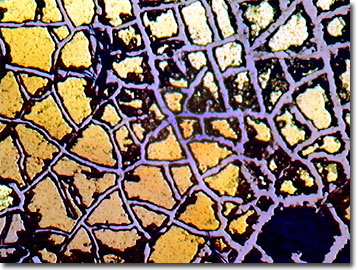Polarized Light Digital Image Gallery
Potassium Chloride (KCl)
Potassium chloride, known to some as "diet salt", reflects similar chemical and crystalline properties to common salt or sodium chloride. Lower grade potassium chloride is used as an ice melting agent that is relatively harmless to vegetation, aquatic ecosystems, and concrete when contrasted to rock salt or sodium chloride.

View a second image of potassium chloride.
To a chemist, potassium chloride is also known as monopotassium chloride, potassium muriate, or potassium monochloride, and features the very simple molecule consisting of a single potassium and chlorine atom that readily dissociate in water into ions. Potassium chloride forms colorless chunks and to geologists, forms the mineral sylvite (or sylvine), a major source of potash for fertilizers and the chemical industry. Often, sylvite crystals have octahedral faces truncating the corners of the cubic crystals. While closely related halite (NaCl or sodium chloride) is salty to taste and creates a powder when scraped with a knife blade, sylvite tastes bitter and will not create the scraped powder. Crystals of sylvite are transparent to translucent, but may be tinted red, blue, or yellow, and melt at 776 degrees Celsius, sublime at 1,500 degrees Celsius, and feature a molecular weight of 74.55. Optical grade potassium chloride, having a refractive index of 1.456, is used for producing infrared windows for Fourier transform infrared (FTIR) spectroscopy and inexpensive, disposal laser protection windows.
Diet salt, usually composed of potassium chloride, is recommended for people that are hypertensive or otherwise require a sodium-free diet. Although sodium is a mineral that is needed throughout the body for proper functioning, using table salt (sodium chloride) as a spice added to food and drink is not always the best idea. Even on a regimented, salt-restricted diet, people still obtain some sodium from natural products such as milk, beets, celery, and drinking water. Processed food products such as Worcestershire sauce, onion salt, soy sauce, garlic salt, bouillon cubes, pretzels, popcorn, and potato chips have relatively large quantities of table salt added. Other major dietary sodium sources are monosodium glutamate, sodium nitrite, sodium benzoate, sodium bicarbonate, and sodium saccharin used for additional flavor or preservation in processed foods. In this fast-food nation, it is very difficult for a person to totally restrict their sodium intake, but it is possible modulate the amount consumed with the help of diet salt.
Contributing Authors
Omar Alvarado, Thomas J. Fellers and Michael W. Davidson - National High Magnetic Field Laboratory, 1800 East Paul Dirac Dr., The Florida State University, Tallahassee, Florida, 32310.
BACK TO THE POLARIZED LIGHT IMAGE GALLERY
BACK TO THE DIGITAL IMAGE GALLERIES
Questions or comments? Send us an email.
© 1995-2025 by Michael W. Davidson and The Florida State University. All Rights Reserved. No images, graphics, software, scripts, or applets may be reproduced or used in any manner without permission from the copyright holders. Use of this website means you agree to all of the Legal Terms and Conditions set forth by the owners.
This website is maintained by our
Graphics & Web Programming Team
in collaboration with Optical Microscopy at the
National High Magnetic Field Laboratory.
Last Modification Friday, Nov 13, 2015 at 01:19 PM
Access Count Since September 17, 2002: 10022
Visit the website of our partner in introductory microscopy education:
|
|
